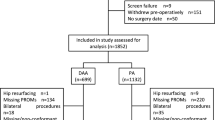Abstract
Introduction
The goal of this study was (1) to identify logistical and clinical areas of importance for length of stay (LOS) by identifying departments with short and long LOS and to evaluate their set-up; and (2) to evaluate patient satisfaction in relation to LOS.
Materials and methods
Based on the National Register on Patients in 2004 on LOS following total hip and knee arthroplasty (THA and TKA), departments with short and long LOS were identified. The three departments with the shortest and the three departments with the longest postoperative hospital stay were chosen for evaluation. The logistic setup and the clinical treatment/pathway were examined with on-location focus interviews to identify logistic and clinical factors acting as improvement or barriers for early rehabilitation and subsequent discharge. Also, the patients from these departments answered a questionnaire regarding satisfaction with components of their stay, co-morbidity, sex and age.
Results
Mean LOS was 7.4 and 8.0 days after THA and TKA, respectively staying from 4.5 to 12 days. Departments with short hospital stay were characterised by both logistical (homogenous entities, regular staff, high continuity, using more time on and up to date information including expectations on a short stay, functional discharge criteria) and clinical features (multimodal opioid-sparing analgesia, early mobilisation and discharge when criteria were met) facilitating quick rehabilitation and discharge. Patient demographics from departments with the shortest stay were similar co-morbidities than patients from departments with longer stays, but were either as satisfied—or more satisfied—with all parts of their stay. There was no difference in staffing (nurses/physiotherapists) between the two types of departments.
Conclusion
Nationwide implementation of fast-track THA and TKA would result in a significant decrease in the needed number of hospital beds with similar or better outcome for the patients. Implementation of updated logistical and clinical features is expected to increase rehabilitation and reduce LOS with similar or improved patient satisfaction. These results support the implementation of fast-track total hip- and knee arthroplasty.
Similar content being viewed by others
References
Kehlet H, Dahl JB (2003) Anaesthesia, surgery and challenges in postoperative recovery. Lancet 362:1921–1928
Møiniche S, Hansen BL, Christensen S-E et al (1992) Patientaktivitet og indlæggelsestid efter hoftealloplastik med balanceret smertebehandling og tidlig mobilisation. Ugeskr Laeger 154:1495–1499
Rasmussen S, Kramhøft MU, Sperling KP et al (2001) Accelereret operationsforløb ved hoftealloplastik. Ugeskr Laeger 163:6912–6916
Husted H, Holm G, Sonne-Holm S (2004) Reduceret indlæggelsesvarighed ved operation med hofte- og knæalloplastik uden brug af yderligere resurser. Ugeskr Laeger 166:3194–3197
Husted H, Holm G, Jacobsen S (2008) Predictors of length of stay and patient satisfaction after hip and knee replacement surgery. Fast-track experience in 712 patients. Acta Orthopaedica 79(2):168–173
Husted H, Holm G, Sonne-Holm S (2005) Accelereret forløb: høj tilfredshed og 4 dages indlæggelse ved hofte- og knæalloplastik på uselekterede patienter. Ugeskr Laeger 167:2043–2048
Healy WL, Iorio R, Ko J, Appleby D, Lemos DW (2002) Impact of cost reduction programs on short-term patient outcome and hospital cost of total knee arthroplasty. J Bone joint Surg 84:348–353
Scranton PE (1999) The cost effectiveness of streamlined care pathways and product standardization in total knee arthroplasty. J Arthroplasty 14(2):182–186
Mauerhan DR, Mokris JG, Ly A, Kiebzak GM (1998) Relationship between length of stay and manipulation rate after total knee arthroplasty. J Arthroplasty 13(8):896–900
Dowsey MM, Kilgour ML, Santamaria NM, Choong PFM (1999) Clinical pathways in hip and knee arthroplasty: a prospective randomised controlled study. Med J Aust 170(2):59–62
Healy WL, Iorio R, Richards JA (1997) Opportunities for control of hospital cost for total knee arthroplasty. Clin Orthop 345:140–147
Mabrey JD, Toohey JS, Armstrong DA, Lavery L, Wammack LA (1997) Clinical pathway management of total knee arthroplasty. Clin Orthop 345:125–133
Macario A, Horne M, Goodman S, Vitez T, Dexter F, Heinen R, Brown B (1998) The effect of a perioperative clinical pathway for knee replacement surgery on hospital costs. Anesth Analg 86(5):978–984
Fisher DA, Trimble S, Clapp B, Dorsett K (1997) Effect of a patient management system on outcomes of total hip and knee arthroplasty. Clin Orthop 345:155–160
Healy WL, Ayers ME, Iorio R, Patch DA, Appleby D, Pfeifer BA (1998) Impact of a clinical pathway and implant standardization on total hip arthroplasty. A clinical and economic study of short-term patient outcome. J Arthroplasty 13(3):266–276
Pearson SD, Kleefield SF, Soukop JR, Cook EF, Lee TH (2001) Critical pathways intervention to reduce length of hospital stay. Am J Med 110(3):175–180
Pearson S, Moraw I, Maddern GJ (2000) Clinical pathway management of total knee arthroplasty: a retrospective comparative study. Aust N Z J Surg 70(5):351–354
Husted H, Holm G, Rud K et al (2006) Indlæggelsesvarighed ved primær total hofte- og knæalloplastik i Danmark 2001 til 2003. Ugeskr Laeger 168:276–279
Smith IDM, Elton R, Ballantyne JA et al (2008) Pre-operative predictors of the length of hospital stay in total knee replacement. J Bone Joint Surg (Br) 90-B:1435–1440
Kehlet H (2005) Postoperative opioid sparing to hasten recovery. What are the issues? Anesthesiology 102:1083–1085
Jakobsen DH, Sonne E, Andreasen J et al (2006) Convalescence after colonic surgery with fast-track vs conventional care. Colorectal Dis 8(8):683–687
Marx RG, Jones EC, Atwan NC et al (2005) Measuring improvement following total hip and knee arthroplasty using patient-based measures of outcome. J Bone Joint Surg 87:1999–2005
Mancuso CA, Salvati EA, Johanson NA et al (1997) Patients’ expectations and satisfaction with total hip arthroplasty. J Arthroplasty 12:387–396
Author information
Authors and Affiliations
Corresponding author
Additional information
This study is part of a larger nationwide survey initiated by CEMTV, National Board of Health (http://www.SST.dk) and is based on three studies published in Ugeskrift Laeger 2006.
Rights and permissions
About this article
Cite this article
Husted, H., Hansen, H.C., Holm, G. et al. What determines length of stay after total hip and knee arthroplasty? A nationwide study in Denmark. Arch Orthop Trauma Surg 130, 263–268 (2010). https://doi.org/10.1007/s00402-009-0940-7
Received:
Published:
Issue Date:
DOI: https://doi.org/10.1007/s00402-009-0940-7




